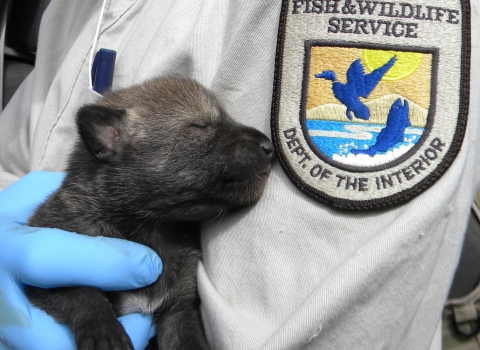KODAK, Tenn. -- Today, the U.S. Fish and Wildlife Service and dozens of conservation partners celebrated the snail darter’s recovery and removal from the Federal List of Threatened and Endangered Wildlife at Seven Islands Birding State Park. The snail darter is the fifth fish species delisted due to recovery in the country and the first in the eastern United States, marking an important milestone in ESA's success in supporting biodiversity.
After an extensive review of the best scientific and commercial information available, the Service found this small freshwater fish -- native to the Tennessee River watershed in Alabama, Georgia, Mississippi and Tennessee -- is no longer in danger of extinction, now or in the foreseeable future.
“The recovery of the snail darter is a remarkable conservation milestone that tells a story about how controversy and polarization can evolve into cooperation and a big conservation success,” said Secretary Deb Haaland. “By protecting even the smallest creatures, we show who we are as a country; that we care about our environment and recognize the interconnectedness of our lands, wildlife and people.”
Across the U.S., more than 260 species of freshwater fish and mussels are at risk of extinction due to the loss, fragmentation and degradation of freshwater streams and rivers. ESA protections benefit these species by raising awareness about conservation threats, inspiring diverse partnerships on their behalf, and helping conserve habitat critical to conservation and recovery.
President Biden’s Bipartisan Infrastructure Law Bipartisan Infrastructure Law
The Bipartisan Infrastructure Law (BIL) is a once-in-a-generation investment in the nation’s infrastructure and economic competitiveness. We were directly appropriated $455 million over five years in BIL funds for programs related to the President’s America the Beautiful initiative.
Learn more about Bipartisan Infrastructure Law makes a $1.4 billion down payment in the conservation and stewardship of America’s public lands, including direct investments in endangered species recovery and conservation and fish passage fish passage
Fish passage is the ability of fish or other aquatic species to move freely throughout their life to find food, reproduce, and complete their natural migration cycles. Millions of barriers to fish passage across the country are fragmenting habitat and leading to species declines. The U.S. Fish and Wildlife Service's National Fish Passage Program is working to reconnect watersheds to benefit both wildlife and people.
Learn more about fish passage . The investments will be invaluable as the Service continues its work across the country.
“As we approach the 50th anniversary of the Endangered Species Act (ESA) in 2023, this little fish is emblematic of what partnerships can do to protect even the most initially controversial species, showing the ultimate importance of the ESA in preserving species for future generations,” said Service Director Martha Williams. “We would like to thank the many partners, including the Tennessee Valley Authority, which made this possible.”
In the 1970s, the snail darter became the center of a Supreme Court ruling, an act of Congress, and a giant proposed dam that threatened it with extinction.
The Service listed the snail darter as endangered in 1975 under the ESA due to the threat of a proposed impoundment for the Tennessee Valley Authority’s (TVA) Tellico Dam near Lenoir City, Tenn. At that time, it was the only known location of the fish. Conservationists sued to stop the dam from being completed because it would likely lead to the extinction of the snail darter. This was the first ESA case to reach the Supreme Court. In 1978, the court ruled in favor of protecting the snail darter.
Congress ultimately exempted the Tellico Dam from ESA consultation requirements so that the dam could be completed, and President Jimmy Carter signed the bill into law in 1979.
Meanwhile, snail darters were collected from the Little Tennessee River and transplanted to the Hiwassee and Holston rivers in Tennessee and then to other locations. Collaborative survey efforts with TVA and state partners also found the fish in several additional streams.
These successful translocations and the subsequent discovery of other natural populations prompted the Service to downlist the snail darter from endangered to threatened on July 5, 1984. Designated critical habitat was also rescinded at that time.
Conservation efforts for the species increased in 1991 when the TVA began implementing strategies to improve habitat and water quality conditions associated with their dams. These efforts benefitted the snail darter throughout its range. Additionally, watershed level conservation efforts were implemented by The Nature Conservancy, the Natural Resources Conservation Service, and local partnerships such as the Thrive Regional Partnership and the Limestone Valley Resource Conservation and Development Council in the Paint Rock River, South Chickamauga Creek, and Sequatchie River watersheds. In tributary watersheds such as the Ocoee and Sequatchie where water quality was impacted by localized mining threats, conditions have improved due in part to the cessation of mining and efforts to clean up the mine sites. In watersheds with higher levels of agriculture and urbanization, conservation programs were put in place to reduce the impact of these activities on the instream habitat used by the snail darter.
The ESA requires the Service to implement a system in cooperation with the states to effectively monitor the status of a species for a minimum of five years after delisting to ensure that it remains stable. The Service will coordinate with other federal agencies, state resource agencies, interested scientific organizations, and others as appropriate to develop and implement an effective post-delisting monitoring plan.
The proposed and final rules, the post-delisting monitoring plan, and the comments received on the proposed rule are available at: http://www.regulations.gov in Docket No. FWS–R4–ES–2020–0152.


